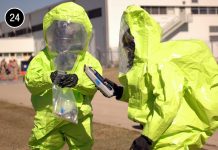Many people are exposed to heat on the job, outdoors or in hot indoor environments. Operations involving high air temperatures, radiant heat sources, high humidity, direct physical contact with hot objects, or strenuous physical activities have a high potential for causing heat-related illness.
Every year, dozens of workers die and thousands more become ill while working in extreme heat or humid conditions. More than 40 percent of heat-related worker deaths occur in the construction industry, but workers in every field are susceptible. There are a range of heat illnesses and they can affect anyone, regardless of age, or physical condition.

OSHA-NIOSH Heat Safety Tool
Take precautions against outdoor heat while at work with the OSHA-NIOSH Heat Safety Tool. Featuring real-time heat index and hourly forecasts, specific to your location, as well as occupational safety and health recommendations from OSHA and NIOSH. The OSHA-NIOSH Heat Safety Tool is a useful resource for planning outdoor work activities based on how hot it feels throughout the day. Android | iPhone

Employer Responsibility to Protect Workers
Under OSHA law, employers are responsible for providing workplaces free of known safety hazards. This includes protecting workers from extreme heat. An employer with workers exposed to high temperatures should establish a complete heat illness prevention program.
- Provide workers with water, rest and shade.
- Allow new or returning workers to gradually increase workloads and take more frequent breaks as they acclimatize, or build a tolerance for working in the heat.
- Plan for emergencies and train workers on prevention.
- Monitor workers for signs of illness.
- Know Your Rights – Under Federal law, you are entitled to a safe workplace. Training also plays a key role in the prevention of accidents.
- OSHA Accepted Provider
- DOL Plastic Card Shipped Within 2 Weeks
- Reg. Price: 10hr: $89 - 30hr: $189
- Enter Promo Code "osha15off" at Checkout


Types of Workplace Affected by Extreme Heat
Workplaces with these conditions may include iron and steel foundries, nonferrous foundries, brick-firing and ceramic plants, glass products facilities, rubber products factories, electrical utilities (particularly boiler rooms), bakeries, confectioneries, commercial kitchens, laundries, food canneries, chemical plants, mining sites, smelters, and steam tunnels.
Outdoor operations conducted in hot weather and direct sun, such as farm work, construction, oil and gas well operations, asbestos removal, landscaping, emergency response operations, and hazardous waste site activities, also increase the risk of heat-related illness in exposed workers.
OSHA Heat Safety Resources
OSHA’s Occupational Exposure to Heat page explains what employers can do to keep workers safe and what workers need to know – including factors for heat illness, adapting to working in indoor and outdoor heat, protecting workers, recognizing symptoms, and first aid training. The page also includes resources for specific industries and OSHA workplace standards. Also look for heat illness educational and training materials on OSHA’s Publications page.
Heat Safety: Industry-Specific Resources
Agriculture
- A Guide to Heat Stress in Agriculture. OSHA and the Environmental Protection Agency (EPA), (May 1993). A guide to help pesticide applicators and agricultural employers set up and operate a heat stress control program.
- OSHA Heat Illness Prevention Training Guide. OSHA, (2011). Also available in Spanish.
- Use OSHA’s Heat Smartphone App. Check the heat index for your worksite and see reminders about the protective measures for the specified risk level.
- Migrant Farm Worker Dies From Heat Stroke While Working on a Tobacco Farm – North Carolina. National Institute for Occupational Safety and Health (NIOSH) FACE Report 2006-04, (August 2007).
- Heat-Related Deaths Among Crop Workers-United States, 1992-2006. Centers for Disease Control MMWR weekly report 57(24): 649-653.
Baggage Screeners
- Hazard Evaluation for Heat Exposure of Baggage Screeners. Health Hazard Evaluation Report 2004-0334-3017, Transportation Security Administration: Palm Beach International.
Construction
- OSHA Heat Illness Prevention Training Guide. OSHA, (2011). Also available in Spanish.
- Use OSHA’s Heat Smartphone App. Check the heat index for your worksite and see reminders about the protective measures for the specified risk level.
- Working in Hot Weather (Construction). Center to Protect Workers’ Rights (CPWR).
Emergency Response and Cleanup
- Heat Stress. OSHA. Emergency Preparedness and Response Health and Safety Guide.
- Occupational Safety and Health Guidance Manual for Hazardous Waste Site Activities, Chapter 8. NIOSH/OSHA/USCG/EPA, (1985).
- Wildland Fire Safety: Heat Stress. USDA Forest Service.
- Heat Illness Basics for Wildland Firefighters. USDA Forest Service.
Foundries
- White Paper: Establishing a Foundry Heat Stress Management Program. OSHA and American Foundry Society (AFS) Alliance, (December 2008). AFS developed, “White Paper: Establishing a Foundry Heat Stress Management Program.” The White Paper is designed to provide foundry industry employers and employees with information that can help control the potential hazards of heat stress.
Health Care
- Nobody Likes It Hot: Preventing Heat Stress in At-Risk Workers. OSHA and The Joint Commission/Joint Commission Resources (JCR) Alliance, (June 2011). JCR developed an article on heat related illnesses, including signs and symptoms of various illnesses and prevention and treatment tactics.
Military
- Heat Illness Prevention & Sun Safety. U.S. Army Public Health Command web page.
- Prevention and Treatment of Heat and Cold Stress Injuries. Navy Environmental Health Center Technical Manual NEHC-TM-OEM 6260.6A, (June 2007).
Oil and Gas
- Oil & Gas and Construction. OSHA, (2013). Also available in Spanish.























